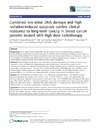Identificador persistente para citar o vincular este elemento:
https://accedacris.ulpgc.es/jspui/handle/10553/9007
| Título: | Combined low initial DNA damage and high radiation-induced apoptosis confers clinical resistance to long-term toxicity in breast cancer patients treated with high-dose radiotherapy | Autores/as: | Henríquez Hernández, Luis Alberto Carmona-Vigo, Ruth Pinar, Beatriz Bordón, Elisa Lloret Saez-Bravo, Marta Núñez, María Isabel Rodríguez-Gallego, Carlos Lara Jiménez, Pedro Carlos |
Clasificación UNESCO: | 320101 Oncología | Palabras clave: | Radio-Induced Apoptosis Peripheral-Blood Lymphocytes Double-Strand Breaks Late Skin Reactions Ataxia-Telangiectasia, et al. |
Fecha de publicación: | 2011 | Publicación seriada: | Radiation Oncology | Resumen: | Background: Either higher levels of initial DNA damage or lower levels of radiation-induced apoptosis in peripheral blood lymphocytes have been associated to increased risk for develop late radiation-induced toxicity. It has been recently published that these two predictive tests are inversely related. The aim of the present study was to investigate the combined role of both tests in relation to clinical radiation-induced toxicity in a set of breast cancer patients treated with high dose hyperfractionated radical radiotherapy. Methods: Peripheral blood lymphocytes were taken from 26 consecutive patients with locally advanced breast carcinoma treated with high-dose hyperfractioned radical radiotherapy. Acute and late cutaneous and subcutaneous toxicity was evaluated using the Radiation Therapy Oncology Group morbidity scoring schema. The mean follow-up of survivors (n = 13) was 197.23 months. Radiosensitivity of lymphocytes was quantified as the initial number of DNA double-strand breaks induced per Gy and per DNA unit (200 Mbp). Radiation-induced apoptosis (RIA) at 1, 2 and 8 Gy was measured by flow cytometry using annexin V/propidium iodide. Results: Mean DSB/Gy/DNA unit obtained was 1.70 ± 0.83 (range 0.63-4.08; median, 1.46). Radiation-induced apoptosis increased with radiation dose (median 12.36, 17.79 and 24.83 for 1, 2, and 8 Gy respectively). We observed that those "expected resistant patients" (DSB values lower than 1.78 DSB/Gy per 200 Mbp and RIA values over 9.58, 14.40 or 24.83 for 1, 2 and 8 Gy respectively) were at low risk of suffer severe subcutaneous late toxicity (HR 0.223, 95%CI 0.073-0.678, P = 0.008; HR 0.206, 95%CI 0.063-0.677, P = 0.009; HR 0.239, 95%CI 0.062-0.929, P = 0.039, for RIA at 1, 2 and 8 Gy respectively) in multivariate analysis. Conclusions: A radiation-resistant profile is proposed, where those patients who presented lower levels of initial DNA damage and higher levels of radiation induced apoptosis were at low risk of suffer severe subcutaneous late toxicity after clinical treatment at high radiation doses in our series. However, due to the small sample size, other prospective studies with higher number of patients are needed to validate these results. | URI: | https://accedacris.ulpgc.es/handle/10553/9007 | ISSN: | 1748-717X | DOI: | 10.1186/1748-717X-6-60 | Fuente: | Radiation Oncology [ISSN 1748-717X ] 2011, v. 6 (60) |
| Colección: | Artículos |
Los elementos en ULPGC accedaCRIS están protegidos por derechos de autor con todos los derechos reservados, a menos que se indique lo contrario.
